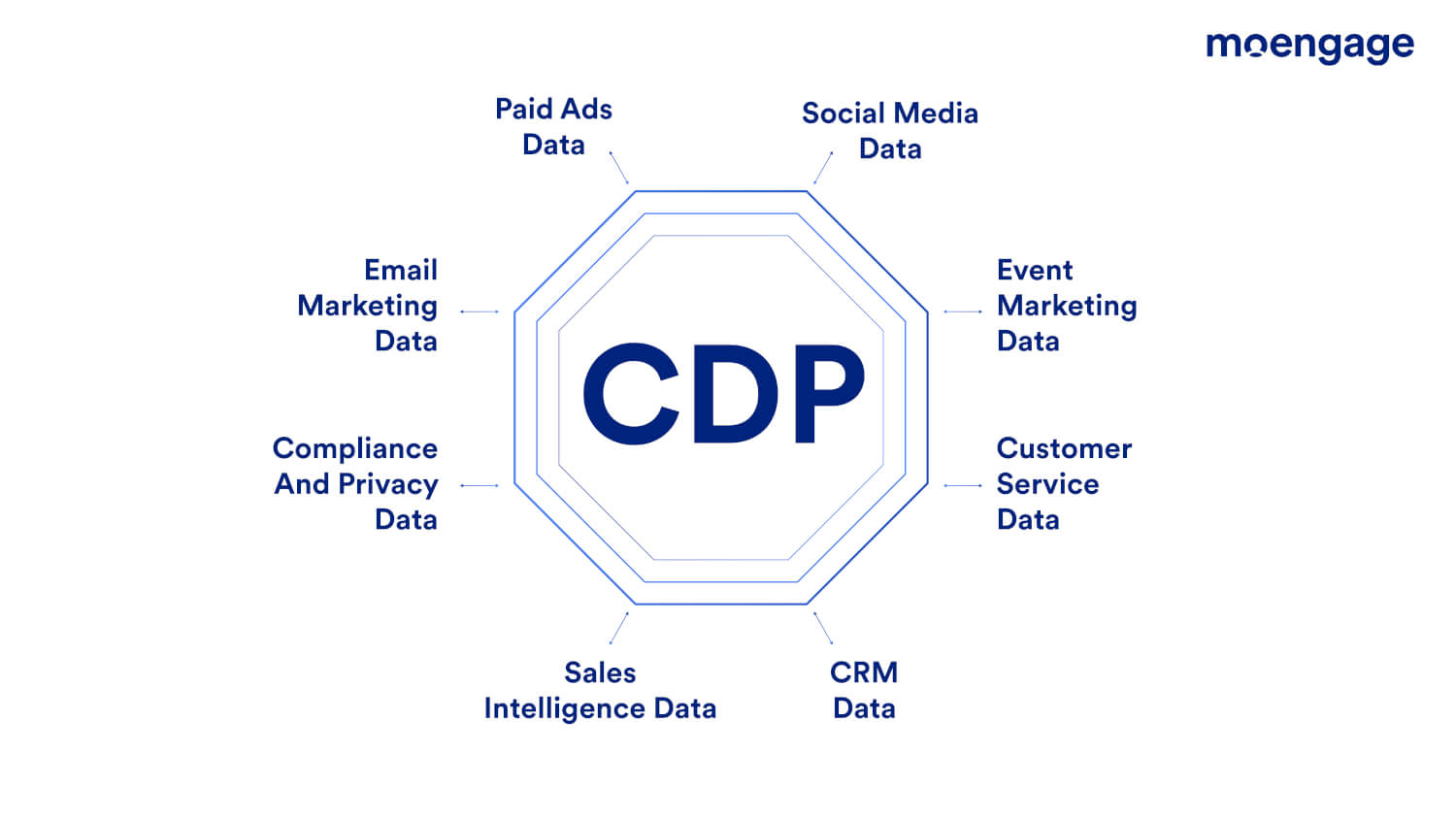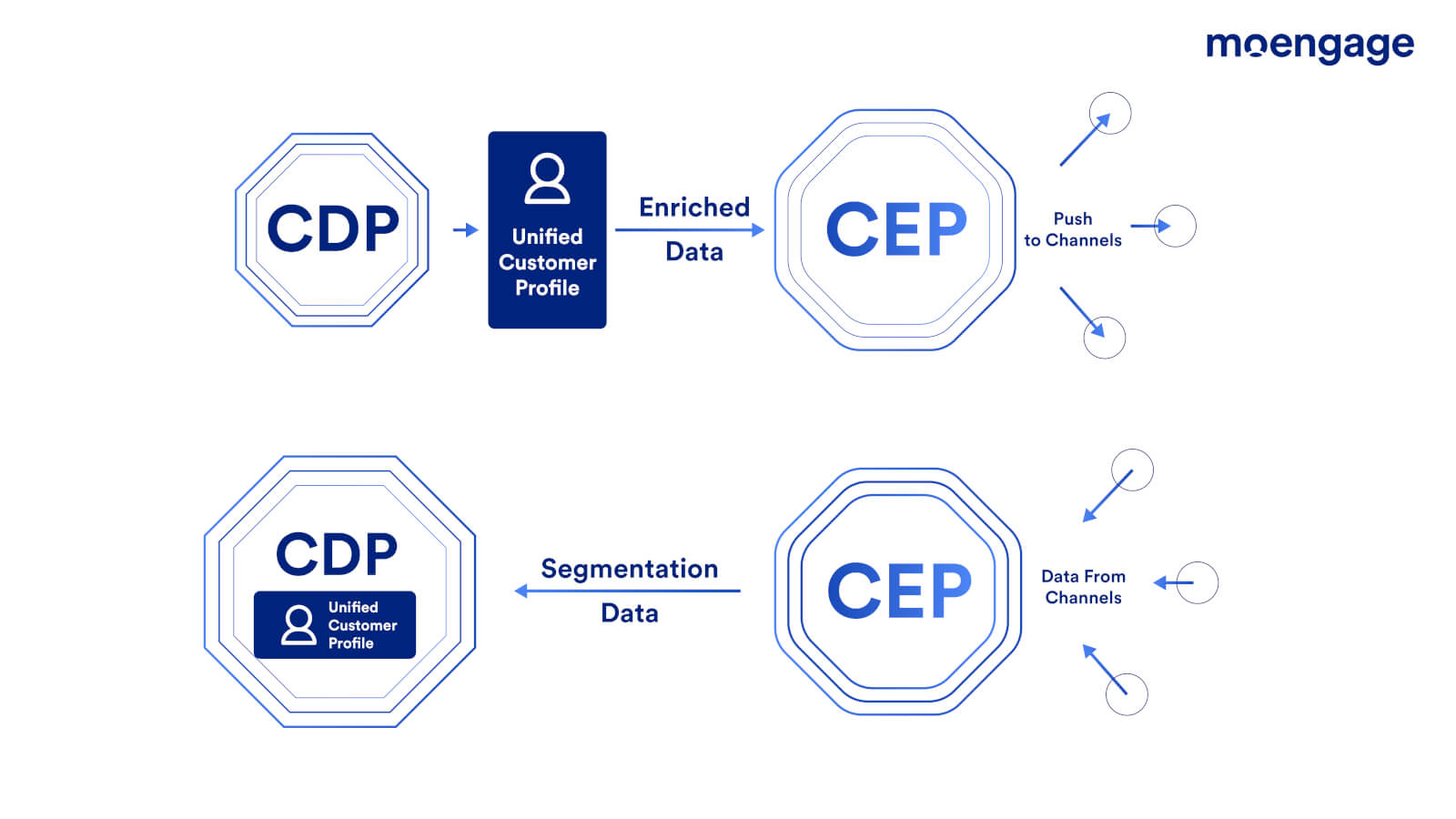Mythbusters: What a Customer Data Platform Is and Using It With a CEP

Reading Time: 8 minutes
There’s a lot of data out there—data about your favorite TV show, your latest Instagram updates, the clothes you want to buy, the kind of news you like to follow, the musicians you hate, and whatnot. Brands collect customer data from every source they can—and you, as a marketer, know this.
But did you know that all these data points collected across different platforms don’t have to be hosted separately? These can all be collated into one place, each data point adding to the other to build out a comprehensive profile for each customer. This blog tells you how it is possible while telling you what a customer data platform (CDP) is and how it compares to and works with a CEP.
What Is The Big Deal About Customer Data?
Each of these customer interactions can mean something to the brand. Each interaction might drive them forward in the customer lifecycle or, if the interactions are negative, drive them out of the funnel.
Information is everything—it helps you understand customer likes and dislikes, decode a pattern behind customer purchases, and predict customer loyalty.
With the right kind of information, you can personalize the entire customer journey for each customer so that every interaction is a meaningful one. There are different types of customer data you can collect, such as:
Transactional Data
- What time did a customer make a purchase?
- How much do they usually spend?
Demographic Data
- How old is your customer, and where do they live?
- What gender do they identify with?
Behavioral Data
- What does your customer like to browse?
- What makes them convert?
Psychographic Data
- Does your customer like discounts?
- Do they enjoy product recommendations?
All this customer data is collected over various tools and platforms deployed by brands for different purposes.
A social media platform, for example, would collect information about a customer’s likes and dislikes on social media, and an event marketing platform would collect data about the kinds of events the customer likes to attend, the number of sessions they’ve attended, their levels of participation, or more.
At the same time, a compliance and data privacy platform would store information about which data points a customer is willing to share with the brand and which ones they’d like to remove from the system.
Apart from this, data is also collected from customer relationship management software, web and mobile analytics tools, sales intelligence platforms, and more.

Each of these tools collect and store data individually, which might lead to wasted resources in terms of repeated data collection and storage costs. This is where a customer data platform (CDP) comes in.
What is a Customer Data Platform (CDP)?
Customer data platforms enable you to collect customer data from multiple sources and collate all data about one customer together to create a unified customer profile.
This means that a customer’s data from the social media platform and their privacy preferences from the compliance management tool would be put together in one place, along with their CRM data, event marketing data, and paid advertising data.
The CDP then combines these data points to build out a unified customer profile. This profile can then be accessed by any of the platforms connected.

So what if customer data is “Connected”?
The benefit of this arrangement is that each platform on the CDP’s network now has enriched data about each customer. By knowing a customer’s privacy preferences, you can decide how many targeted ads you can send them.
By understanding their social media behavior, you can, in turn, change their lead status in the customer relationship management (CRM) software.
Okay. Customer data is great, but what can you do with it?
Every data point is important, be it transactional data, behavioral data, first-party data, customer support data, or third-party data. Even so, first-party customer data is like a gem in your warehouse.
This kind of customer data enables you to understand what customers really want, analyze customer interactions to figure out what’s working and what isn’t, predict customer behavior, and create personalized marketing campaigns that prevent churn or promote conversion.
This is made possible with the help of CEPs, or customer engagement platforms. CEPs work on similar principles as customer data platforms but perform a different function. While customer data platforms collect data and create a complete unified customer view, CEPs enable you to understand that data to create meaningful engagement campaigns for every customer.
What does a CEP do?
Platforms like CEPs enable you to send targeted messaging over various channels such as email, SMS, chat, push notifications, and more. CEPs come equipped with intelligent segmentation and personalization capabilities that help you understand each customer’s unique requirements and tailor communication accordingly.
CEPs have a native machine-learning aspect that helps you analyze, gain insights, predict, and engage with customers the way they want to be spoken to over a channel they enjoy interacting with.
How is a CEP different from a CDP?
A CEP is different from a customer data management platform. CEPs allow you to engage with customers. CDPs specialize in unifying your customer data into one place to increase your operational efficiency.
What Kind of Analyses Do CEPs Help With?
A CEP is an integrated customer engagement solution that enables you to analyze customer interactions and customer data points across online and offline channels. Here are a couple of examples of analyses you can perform with CEPs like MoEngage:
User Path Analysis

Understand every step your customers take after an event, such as ‘app install,’ or before an event of your choice, such as churn. Figure out how many customers take each path towards the intended goal and why some of them drop off from the funnel.
Intelligent RFM Segmentation

Automatically segment your customers to identify the ones who are price-sensitive. You can also identify champion customers, loyalists, hibernating, or the ones that need attention.
Create targeted messaging campaigns that address each customer’s specific needs. The segment that needs attention, for example, can be sent a discount campaign incentivizing them to return to your product.
The segment that contains potential loyalists can be teased about an exclusive premium-access feature.
Customer Journey Optimization

Not all customers are the same. Some of them might prefer reading emails, while others might respond better to push notifications. This is why you can’t deploy the same messaging strategy to all customers.
You need to understand which channels work best for each individual and tailor communication to them accordingly, and each message must be relevant to the stage of the customer lifetime.
For a customer who has purchased a shoe, you can send a transactional email confirming the purchase. For customers who haven’t made the purchase, you can send a cart abandonment message over an SMS.
CEPs Are a One-Stop Solution for Your Engagement Needs
CEPs empower you to create multi-step campaigns that reach customers over a combination of channels based on specific actions undertaken.
This is how CEPs help marketers—the data collected encompasses multiple customer touchpoints. CEPs help you analyze customer interaction data and build out an accurate customer profile so you can engage with customers over multiple channels and increase customer lifetime value.
Should brands use Customer Data Platforms or CEPs?
Ideally, the question you should be asking is not ‘CDP vs. CEP,’ or ‘how do you choose between a customer data platform and a CEP’. The question should instead be, ‘how does a customer data platform work in tandem with a CEP?’
To answer this question, let us take a look at what benefits a customer data platform can bring to a CEP and likewise.
Benefits of The CDP + CEP Integration
CDPs collect data directly from the source. This can be transaction data, external systems data, customer identity resolution data, or other customer data records. Then, the customer data platform automatically performs data analysis. Next, a unified profile is created for each customer to eliminate data silos and create a single source of truth.
CEPs can access this unified customer database to understand what each customer likes or dislikes and what works for them across multiple systems to create more personalized marketing campaigns and a consistent customer experience.
These campaigns can be sent to each customer over channels such as email, SMS, push notifications, or in-app messaging.
CEPs like MoEngage allow you to intelligently identify customers’ preferences, thereby creating optimized audience segments based on customer insights. You can create a personalized customer experience based on each customer’s preferences across online and offline touchpoints.
Every interaction the customer has with these messages is sent back to the CEP, can then analyze data and send it forward to the customer data platform.
The customer data platform can now ingest data about a customer’s engagement metrics. For example, which channel they respond on and when they are likely to open emails or push notifications.
CEPs can also help marketers perform advanced customer journey orchestration. CDPs then send customer profiles of those who react well to each journey, back to the customer data platform.
The customer data platform can integrate this information with the existing unified customer profile, thus enriching it further for other systems to benefit.
The other platforms can now access information about how a customer engages with different channels and different types of messaging. This is a bidirectional data integration.

Emerging Data Privacy Regulations
If you’re wondering about emerging data privacy regulations, you can be assured that CEPs like MoEngage and other data management platforms will adhere to any data protection regulations for the country they operate in.
Security at MoEngage
At MoEngage, we take data privacy, security, and compliance very seriously. All the data collected via MoEngage is processed securely and adheres to global and regional data privacy and security standards.
MoEngage offers a SAML (Security Assertion Markup Language)-based SSO (single sign-on), ensures strict levels of GDPR (General Data Protection Regulation) compliance, CCPA (California Consumers Protection Act) compliance, ISO (International Organization for Standardization) 27001 certified, and SOC 2 (Service Organization Controls) Type 1 compliant.
Security at Scale
MoEngage has been built to handle massive scale. MoEngage processes 1 trillion data points, 80 billion messages, and over 1 billion emails monthly. At this scale, the brand engages with over 900 million MAUs (monthly active users) each month.
If you’re looking for more specifics, you can check out MoEngage’s security adherence here.
CDP + CEP is The Way To Go Forward
Marketers worldwide are realizing the benefits of a combined CDP + CEP solution. This helps a marketing team make the best of multiple data sources, be it first-party data or data from other systems.
This combination helps manage customer data from different data sources, uses machine learning to perform customer analytics, and makes sure that connected data sources reap the benefits of the integration.
The Bottomline
CDPs help you bring existing data together in one place to create unified customer profiles. CEPs help activate customer data to create more relevant marketing campaigns than ever before.
By creating personalized marketing campaigns, you can ensure that each customer experience is delightful.
About the CDP vs. CEP Infographic
We’ve created an infographic to help you understand what a customer data platform is, what makes customer data important, how a CEP helps, and why you should make the best of a CDP+CEP combination rather than choose one platform from the two. You can check this infographic out here.
Talk to Us
If you have any more questions about CDPs or CEPs and how to integrate them to create a uniform customer data management and engagement system, you can contact us or schedule a demo at a time of your convenience.







